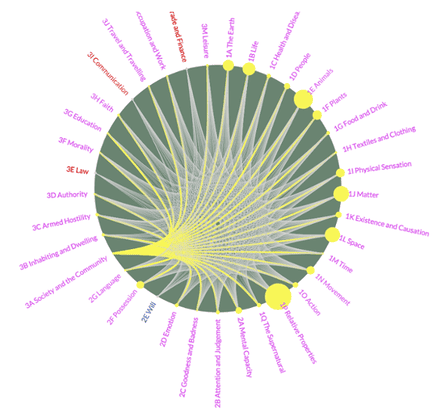Metaphor is not the sole preserve of Shakespearean scholarship or high literary endeavour but has governed how we think about and describe our daily lives for centuries, according to researchers at Glasgow University.
Experts have now created the world’s first online Metaphor Map, which contains more than 14,000 metaphorical connections sourced from 4m pieces of lexical data, some of which date back to 700AD.
While it is impossible to pinpoint the oldest use of metaphor in English, because some may have been adopted from earlier languages such as Germanic, the map reveals that the still popular link between sheep and timidity dates back to Old English. Likewise, we do not always recognise modern use of metaphor: for example, the word “comprehend” comes from Latin, where it meant to physically grasp an object.
The three-year-long project to map the use of metaphor across the entire history of the English language, undertaken by researchers at the School of Critical Studies, was based on data contained in the Historical Thesaurus of English, which spans 13 centuries.
Dr Wendy Anderson, the project’s principal investigator, said that the findings supported the view that metaphor is pervasive in language and is also a major mechanism of meaning-change.
“This helps us to see how our language shapes our understanding – the connections we make between different areas of meaning in English show, to some extent, how we mentally structure our world”, she said.

“Over the past 30 years, it has become clear that metaphor is not simply a literary phenomenon; metaphorical thinking underlies the way we make sense of the world conceptually. It governs how we think and how we talk about our day-to-day lives.”
For example, when we describe a “healthy economy” or a “clear argument”, we are mapping from one domain of experience that is quite concrete, such as medicine or sight, onto another domain that is rather more abstract, in this case finance or perception, and thus benefits from metaphorical explanation.
Anderson adds that the main conclusion of the mapping exercise is “just how pervasive metaphor is”. “The sheer volume of it is amazing. This is not a new phenomenon. It’s something that we have always done.”
The Map also uncovers some revealing metaphorical clusters, such as the number of links between textiles and social structure. We describe social networks in terms of weaving and spinning; something is defined as “tweedy” if it is rustic, or “chintzy” if petit bourgeois. Textiles also influence the way that we talk about imagination: we “spin a yarn” and “embroider our thoughts”.
The Metaphor Map is still a work in progress, with only a quarter of the connections currently online. The researchers plan to launch a parallel Metaphor Map for data from Old English, used prior to 1150AD, in August.

Comments (…)
Sign in or create your Guardian account to join the discussion